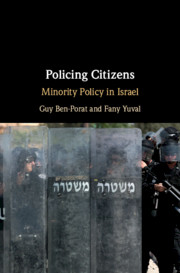Book contents
- Policing Citizens
- Policing Citizens
- Copyright page
- Contents
- Tables
- Introduction: Policing Citizens
- 1 Theoretical Framework
- 2 Police and Policing in Israel
- 3 Arab Citizens: National Minority and Police
- 4 The Skin Color Effect: Police and the Jews of Ethiopian Descent
- 5 The Religious Factor: Ultra-Orthodox Jews (Haredim)
- 6 Integration and Citizenship: Russian Immigrants
- 7 Conclusions
- Bibliography
- Index
5 - The Religious Factor: Ultra-Orthodox Jews (Haredim)
Published online by Cambridge University Press: 26 July 2019
- Policing Citizens
- Policing Citizens
- Copyright page
- Contents
- Tables
- Introduction: Policing Citizens
- 1 Theoretical Framework
- 2 Police and Policing in Israel
- 3 Arab Citizens: National Minority and Police
- 4 The Skin Color Effect: Police and the Jews of Ethiopian Descent
- 5 The Religious Factor: Ultra-Orthodox Jews (Haredim)
- 6 Integration and Citizenship: Russian Immigrants
- 7 Conclusions
- Bibliography
- Index
Summary
Ultra-Orthodox Jews (Haredim) took to the streets in May 1949, after the owner of a movie theater in Jerusalem refused to yield to demands to close on Sabbath. The stormy demonstration on May 25, 1949, was broken up violently by the police, thereby arousing an additional storm of protest by the Haredi public and a government nominated committee of inquiry was set up to investigate the events (Friedman, 1994). The struggle in Jerusalem was unique, as the Haredim were insistent to defend the Sabbath and secular groups, including some from outside the city, organized to thwart Haredi intentions. These battles in Jerusalem between the religious and secular continued, with different reasons and intensities, and with police called in to bring order. In one of the fiercest demonstrations in 1956, Pinchas Segalov, a Haredi protester, was killed; his image became a symbol of the struggle to keep the Sabbath among the Haredi circles, and especially in the Haredi community (Cohen, 1997), and of the tensions between Haredim and the police.
- Type
- Chapter
- Information
- Policing CitizensMinority Policy in Israel, pp. 143 - 173Publisher: Cambridge University PressPrint publication year: 2019



